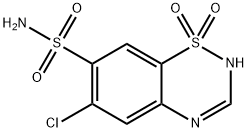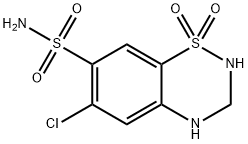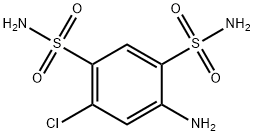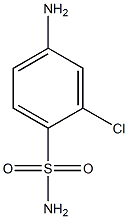Chlorothiazide , 99% , 58-94-6
Synonym(s):
6-Chloro-2H-1,2,4-benzothiadiazine-7-sulfonamide 1,1-dioxide
CAS NO.:58-94-6
Empirical Formula: C7H6ClN3O4S2
Molecular Weight: 295.72
MDL number: MFCD00058576
EINECS: 200-404-9
| Pack Size | Price | Stock | Quantity |
| 1g | RMB44.00 | In Stock |
|
| 5g | RMB108.80 | In Stock |
|
| 25g | RMB318.40 | In Stock |
|
| 100g | RMB854.40 | In Stock |
|
| others | Enquire |
PRODUCT Properties
| Melting point: | 342-343°C |
| Boiling point: | 608.8±65.0 °C(Predicted) |
| Density | 1.7303 (rough estimate) |
| refractive index | 1.6100 (estimate) |
| storage temp. | 2-8°C |
| solubility | DMSO (Slightly), Methanol (Very Slightly, Heated) |
| form | Solid |
| pka | 6.85, 9.45(at 25℃) |
| color | White to Off-White |
| Water Solubility | <0.1 g/100 mL at 19.5 ºC |
| Merck | 14,2168 |
| BCS Class | 4 |
| Stability: | Stable. Incompatible with strong oxidizing agents. |
| LogP | -0.240 |
| CAS DataBase Reference | 58-94-6(CAS DataBase Reference) |
| NIST Chemistry Reference | Chlorothiazide(58-94-6) |
| EPA Substance Registry System | Chlorothiazide (58-94-6) |
Description and Uses
Chlorothiazide is a first-in-class thiazide diuretic initially discovered from its ability to inhibit carbonic anhydrase in vitro. As an antihypertensive agent, this thiazide increases renal excretion of sodium, potassium, chloride, and bicarbonate ions by inhibiting tubular reabsorptive mechanisms.
Chlorthiazide is a diuretic that causes the body to excrete excess fluid. This drug exhibits strong diuretic action during both acidosis and alkalosis. It is used for arterial hypertension, in edematous syndromes of various genesis, congestive effects in cardiovascular insufficiency, nephrosis and nephritis, and toxicosis. It is especially recommended for hypertonic illnesses. It lowers intraocular pressure in a number of cases.
Safety
| Symbol(GHS) |  GHS08 |
| Signal word | Danger |
| Hazard statements | H317-H334 |
| Precautionary statements | P261-P272-P280-P284-P302+P352-P304+P340+P312 |
| Hazard Codes | Xn |
| Risk Statements | 42/43-20/21/22 |
| Safety Statements | 36 |
| WGK Germany | 2 |
| RTECS | DK9450000 |
| HS Code | 2935904000 |
| Hazardous Substances Data | 58-94-6(Hazardous Substances Data) |




